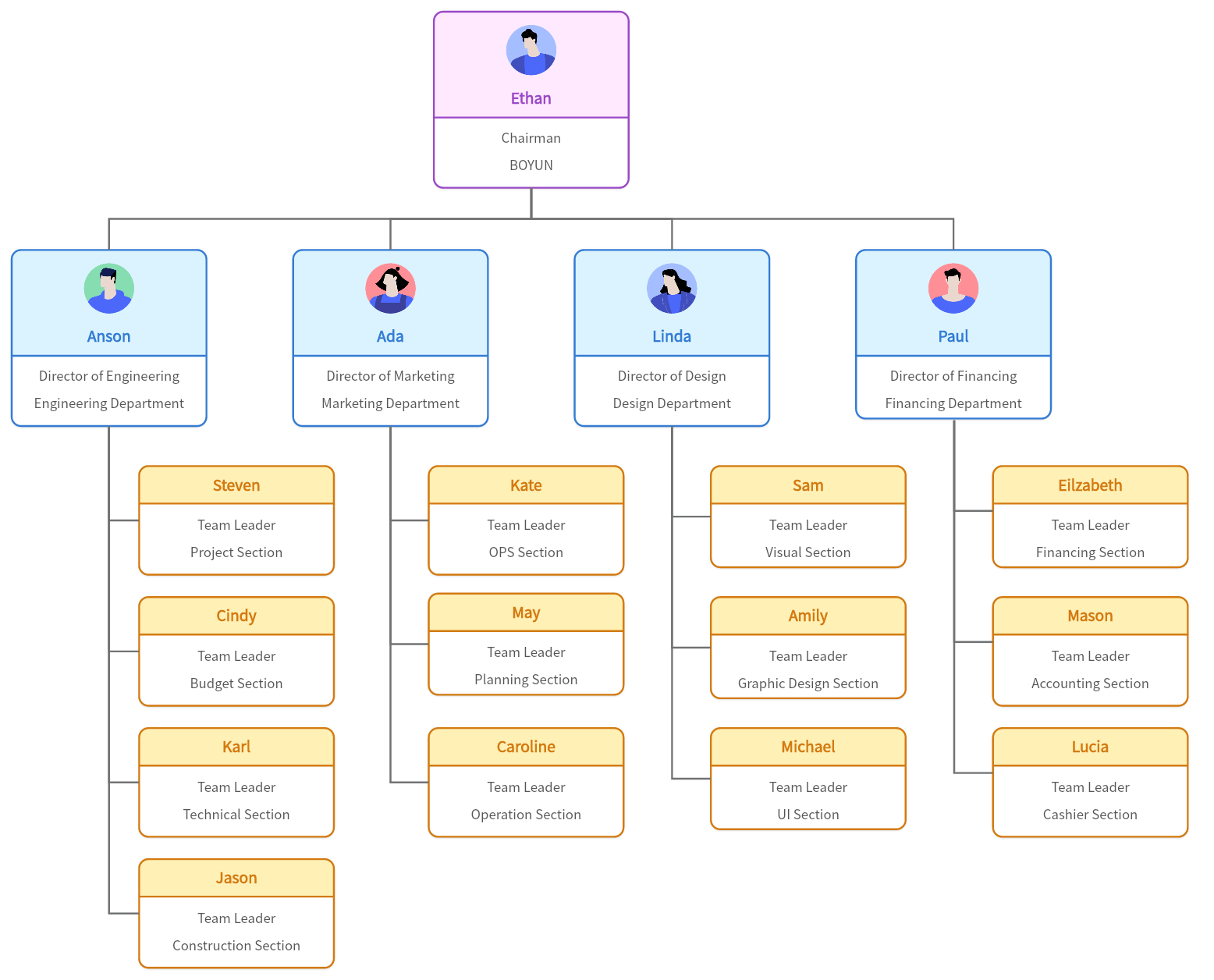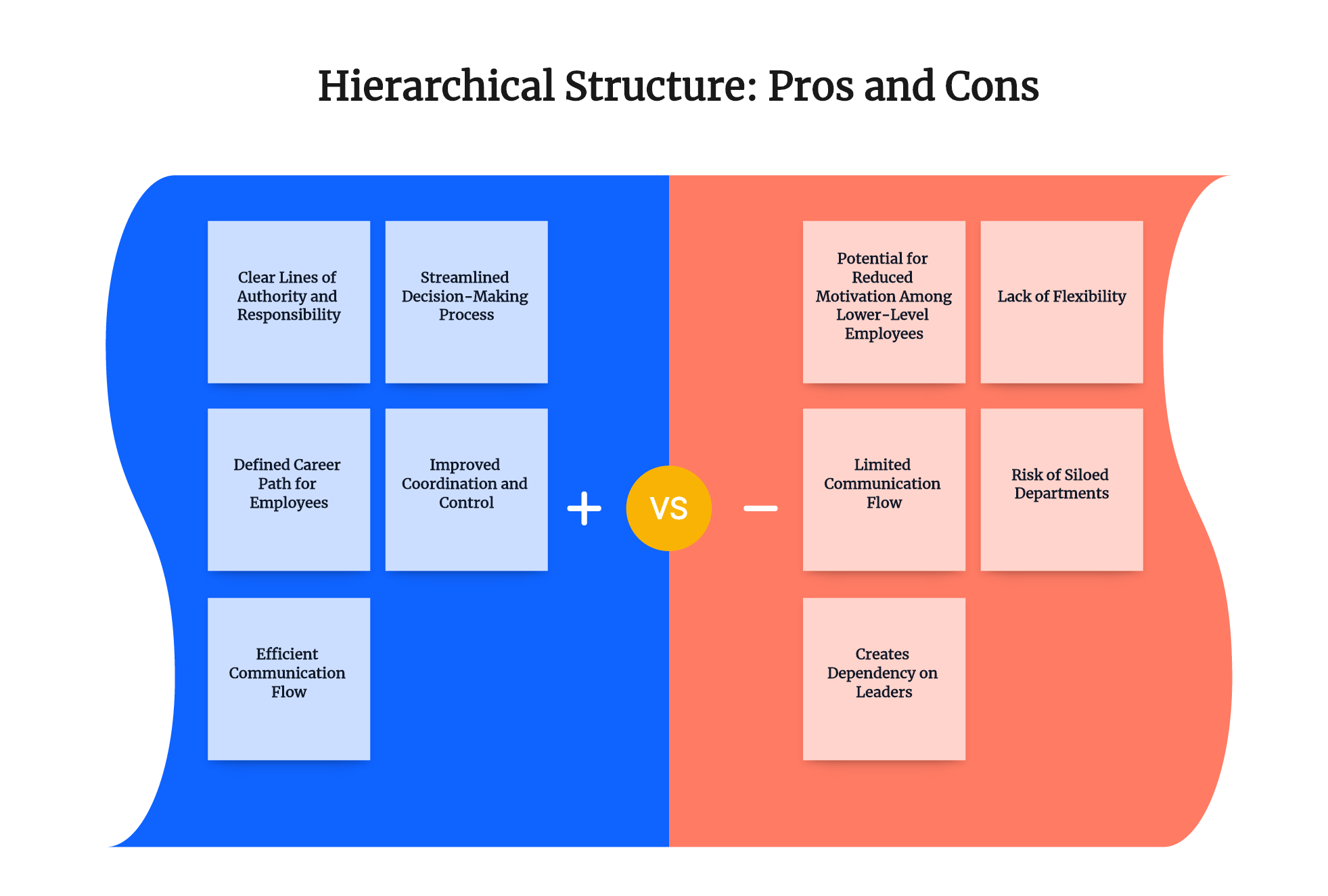In the business world and beyond, hierarchical structures play an integral role. They provide a method of organization that has proven to be both effective and efficient. With such a vast influence, it's crucial to comprehend what hierarchical structures are, how they work, and where they can be found. In this comprehensive guide, we delve deep into these topics and explore the advantages and disadvantages of hierarchical structures.
What is a Hierarchical Structure?
At its core, a hierarchical structure refers to an arrangement where individuals or elements are ranked according to their level of authority or significance. Picture a pyramid - at the top sits the highest level of power, and as you move down, the levels of power decrease correspondingly. This method of organization is particularly prominent in businesses, where the structure may consist of the CEO at the top, followed by other executives, middle management, and then employees at the base.

How Does a Hierarchical Structure Work?
Understanding how a hierarchical structure functions requires a look at its two primary functions: decision-making and communication.
In a hierarchical organization, decision-making is top-down. Those at the apex of the hierarchy, typically executives or upper management, make crucial decisions concerning the organization's direction. This top-down approach enables the higher tiers to set goals and define strategies for the organization. It ensures that decisions are based on a comprehensive view of the organization's needs and objectives. Once decisions are made, they're passed down to middle managers who translate these decisions into operational plans and further down to lower-level employees for implementation.
Communication in a hierarchical structure also follows a similar pattern. Upper management communicates the organization's goals, policies, and directives down the line to the staff at lower levels. Likewise, feedback, reports, and suggestions move upwards from lower-level staff to middle management and eventually to the top executives. This flow of information ensures that everyone within the organization is on the same page, working towards the same goals.
In essence, a hierarchical structure creates an orderly system where roles, responsibilities, and lines of authority are well-defined. It promotes efficiency and creates a sense of order and predictability within the organization.
Advantages of Hierarchical Structures
Hierarchical structures bring several benefits to the table, each contributing to the efficiency and functionality of an organization. Here are some of the key advantages:
Clear Lines of Authority and Responsibility: In a hierarchical structure, every role has a distinct place in the hierarchy, with clear lines of authority mapped out. This delineation reduces confusion and makes it clear who is responsible for which tasks and who answers to whom. By providing this clarity, hierarchical structures can significantly enhance the operational efficiency of an organization.
Streamlined Decision-Making Process: Hierarchical structures follow a top-down approach when it comes to decision-making. Decisions are made by the upper echelons of the organization and flow downwards. This centralized process facilitates uniformity in direction and purpose throughout the organization. It eliminates potential conflicts or confusion that can arise from decentralized decision-making systems, allowing for faster implementation of strategies and quicker responses to any challenges.
Defined Career Path for Employees: Hierarchical structures provide a clearly defined career path for employees, offering a sense of direction for their professional growth. With each level in the hierarchy representing a potential promotion or increase in responsibility, employees have a tangible goal to strive for. This can serve as a strong motivational tool and contribute to increased job satisfaction and employee retention.
Improved Coordination and Control: A hierarchical structure affords higher-level managers better control over operations. Since each role and its responsibilities are clearly defined, coordination between different functions and levels becomes much easier. Managers can monitor their respective teams more effectively, promptly identify any issues, and implement necessary corrections. This level of control can lead to a more streamlined and efficient operation.
Efficient Communication Flow: Hierarchical structures are designed to facilitate clear and efficient communication flow. Top-level managers pass down instructions and decisions effectively through the ranks. At the same time, feedback and ground-level information can move upwards through the hierarchy. This two-way communication channel ensures all members of the organization stay informed and aligned with the organizational objectives.
Disadvantages of Hierarchical Structures
While hierarchical structures provide several benefits, they also possess certain disadvantages. These are crucial to consider for any organization considering adopting this structure.
Potential for Reduced Motivation Among Lower-Level Employees: Hierarchical structures, with their top-down decision-making process, often centralize power and control at the upper levels. This setup can leave employees in lower tiers with limited decision-making authority and involvement in crucial matters. Consequently, they may feel disempowered or overlooked, leading to reduced motivation and job satisfaction. In the long run, this could negatively impact their performance and the overall productivity of the organization.
Lack of Flexibility: Hierarchies, due to their structured nature, may lack the agility required to swiftly adapt to dynamic market conditions or changing customer expectations. In these structures, decisions often need to pass through multiple layers before they are implemented. This bureaucracy can result in slower response times and could potentially impede innovation, making it difficult for the organization to stay competitive in fast-paced industries.
Limited Communication Flow: While hierarchical structures facilitate a clear top-to-bottom communication flow, they often don't promote effective lateral or bottom-up communication as well. The rigid chain of command could inhibit the free exchange of ideas, constructive criticism, or feedback from lower-level employees to the top management. This can lead to missed opportunities for improvement and innovation arising from those who are on the front lines of operations.
Risk of Siloed Departments: In a hierarchical structure, there's a risk that departments might become siloed or too inward-focused. Each department, with its distinct set of responsibilities and goals, may focus exclusively on its tasks without considering the bigger picture or collaborating effectively with other departments. This lack of interdepartmental cooperation can hinder overall organizational effectiveness and growth.
Creates Dependency on Leaders: In a hierarchical organization, the decision-making capacity, strategic vision, and general performance of its leaders play a significant role in its success or failure. This heavy reliance on a few individuals at the top creates risks. If leaders fail to perform optimally, make poor decisions, or lack strategic foresight, it could have severe ramifications on the entire organization.

Examples of Hierarchical Structures in Different Sectors
Hierarchical structures are commonplace in many different sectors, with organizations leveraging their advantages to maintain order and structure. Here are some examples:
Corporate Sector - Apple Inc.: One of the most iconic examples of a hierarchical structure is seen in Apple Inc. This tech giant follows a traditional hierarchical organizational structure, with clearly defined roles across various levels, from top executives down to entry-level employees. The decision-making process primarily involves the upper tiers of management, emphasizing control and centralized power. While this structure has often been criticized for potential creativity stifling, it has nevertheless contributed to Apple's success by ensuring effective resource management and decision-making.
Healthcare Sector - Hospitals: Most hospitals also operate based on a hierarchical structure. This is evident from the clear divisions among doctors, nurses, administrative staff, and custodial workers. Such a hierarchy is essential to ensure that patient care remains organized and streamlined. Every role, from the chief physician to the janitor, is crucial and clearly defined, ensuring the smooth operation of the hospital.
Government - United States Federal Government: The U.S. federal government also operates as a hierarchical structure. At the top is the President, followed by the Vice President, Cabinet members, senators, and congresspersons. Each level has a clear set of duties and responsibilities, ensuring the government functions effectively and that accountability is maintained.
Educational Institutions - Universities: Universities follow a hierarchical structure that starts with the Board of Regents or Trustees at the top. Below them are the President or Chancellor, Deans of different departments, professors, associate professors, and so on. This structure allows for a clear division of responsibilities and effective management of educational institutions.
Alternative Organizational Structures to Hierarchical Structure
While hierarchical structures provide order and a clear chain of command, they are not the only effective organizational structure. Several alternative structures exist, each with its advantages and suited to different types of organizations. Let's explore some of these alternatives.
Matrix Structure: The matrix structure combines two or more types of organizational structures, typically functional and product-based divisions. In a matrix structure, employees have dual reporting relationships - usually with a functional manager and a product manager. This structure encourages fluid and efficient collaboration between different departments, fostering innovation and quicker decision-making. However, it may also lead to potential confusion or conflict due to dual authority. Notable companies using the matrix structure include Philips and Caterpillar.
Flat Structure: A flat structure, also known as a horizontal or flatter organization, reduces the number of management layers and promotes an egalitarian culture. This approach is commonly found in startups and smaller companies where fast decision-making and flexibility are key. In this structure, employees often have more autonomy, fostering creativity and innovation. The potential downside includes a lack of clear career progression paths and the risk of blurred roles and responsibilities. Renowned tech companies like Valve Corporation have adopted a flat organizational structure.
Network Structure: Network structures, often found in companies that outsource several of their operations, create a web of relationships with external entities like suppliers, outsourcing partners, and freelancers. This flexible structure allows organizations to leverage the specialized skills and cost advantages of their partners, though managing these complex relationships can be challenging. Many multinational corporations, including Samsung, use a network structure.
Divisional Structure: In divisional structures, an organization is divided into multiple, semi-autonomous units or divisions, each responsible for a product line or market service. These divisions can operate independently, with their own set of functions like HR, finance, marketing, etc. This structure promotes accountability but may result in duplication of resources. Large corporations with diverse product lines, like Procter & Gamble, use a divisional structure.
Team-Based Structure: In team-based structures, the organization is comprised of various teams working on specific tasks or projects. This structure encourages collaboration, innovation, and flexibility. However, it requires strong team leadership and clear communication to avoid role ambiguity or conflict. Companies such as Spotify have implemented a team-based structure.
All these alternative organizational structures offer different benefits and challenges. The choice of organizational structure should be tailored to an organization's nature, size, industry sector, and strategic objectives.
To learn more about different types of organizational structures, you might want to check out our article 8 Types of Organizational Structures for Businesses.













